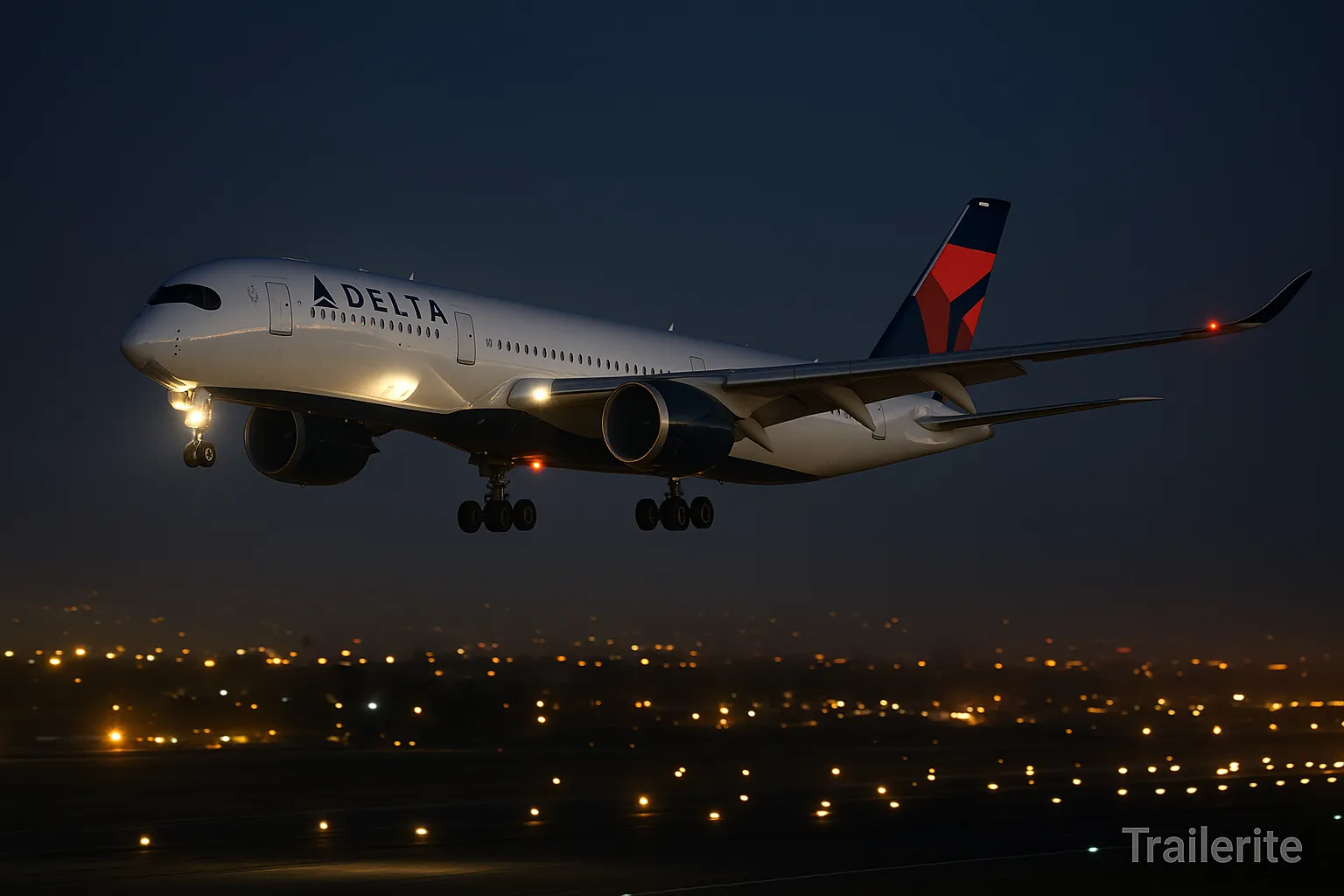On May 28, 2025, passengers aboard Delta Flight DL275 experienced an unexpected but skillfully handled diversion to Los Angeles International Airport (LAX). What began as a routine international journey from Detroit to Tokyo Haneda turned into a textbook case of aviation safety, technology, and quick decision-making.
According to official details and reports reviewed by Trailerite.com, the flight’s Airbus A350-900, powered by Rolls-Royce Trent XWB engines, encountered a critical engine anti-ice system malfunction mid-flight. The crew’s swift response and decision to divert ensured everyone on board arrived safely, without injuries — a story that now stands as an example of how technology and training combine to protect lives.
What Happened Aboard Delta Flight DL275 Before the Diversion
The flight departed from Detroit Metro Airport in the evening, fully loaded with over 300 passengers, several tons of cargo, and a long-range fuel plan for its nonstop journey to Tokyo.
For the first several hours, operations were smooth. The aircraft maintained altitude around 37,000 feet over the North Pacific, west of Alaska. However, approximately five hours into the flight, pilots noticed unusual readings from one of the Rolls-Royce Trent XWB’s anti-ice systems, which are crucial when flying through sub-freezing zones.
The engine anti-ice system prevents ice from forming on internal components, a risk that can lead to thrust instability or even engine stall. When sensors started showing abnormal temperature and pressure readings, the crew followed strict safety protocols — opting to divert to the most suitable airport capable of handling such a large aircraft.
Why the Pilots Chose Los Angeles for an Emergency Diversion
While several airports along the Pacific coast could technically accommodate the Airbus A350, Los Angeles International Airport (LAX) was the optimal choice for three main reasons:
- Maintenance and Expertise: LAX is a major Delta hub, housing certified technicians, Airbus parts, and Rolls-Royce maintenance crews.
- Runway Capacity: Its long runways are ideal for handling heavy international aircraft, especially those carrying surplus fuel during unscheduled diversions.
- Passenger Support: From rebooking to hotel accommodations, LAX offers infrastructure to manage disrupted international flights quickly and efficiently.
At approximately 1:08 AM local time, Delta Flight DL275 diverted LAX successfully and landed without incident. Ground teams immediately inspected the aircraft while passengers were assisted with overnight arrangements and onward travel.
Understanding the Engine Anti-Ice System Failure
The anti-ice system operates by channeling hot bleed air from the engine’s compressor section to warm critical surfaces, keeping them free of ice at high altitude.
Data from onboard sensors during the incident showed:
- Airflow dropped nearly 50%
- Bleed air pressure reduced by 25%
- Valve response slowed over 300%
- Surface temperature fell 30% below normal
These readings signaled an imminent risk of ice formation inside the engine housing. Continuing toward Tokyo would have meant flying for several more hours over freezing oceanic airspace — far from emergency landing options. The pilots’ quick decision prevented what could have developed into a severe mechanical emergency.
Could AI Have Predicted the Delta Flight DL275 Diverted LAX Incident?
Yes — and that’s where aviation is headed.
As Trailerite.com highlights in several aviation technology reports, predictive maintenance AI can analyze real-time flight data across thousands of prior engine cycles. The Airbus A350 generates around 2.5 terabytes of flight data per trip — a goldmine for pattern recognition systems.
Had an advanced AI engine health monitor been active, it might have spotted the gradual degradation in the anti-ice valve and airflow readings days or even hours before departure, allowing Delta engineers to address the issue during ground checks.
Experts estimate predictive maintenance could reduce in-flight technical events by up to 78%, saving airlines millions in disruption and maintenance costs each year.
Financial Impact of the Diversion
Incidents like this are not only operationally challenging — they’re expensive. Based on similar industry case studies, the estimated costs for this event include:
| Category | Estimated Cost (USD) |
|---|---|
| Extra fuel for rerouting | $180,000 |
| LAX emergency landing fees | $12,000 |
| Engine diagnostics & maintenance | $95,000 |
| Crew overtime & accommodations | $45,000 |
| Passenger rebooking & care | $135,000 |
| Lost Tokyo flight revenue & cargo | $1.8 million |
| Total Estimated Impact | ≈ $2.3 million |
These numbers show how even well-managed diversions carry substantial financial ripple effects.
Passenger Experience and Brand Response
Though everyone landed safely, the diversion disrupted travel plans for hundreds of passengers. Delta’s customer care teams at LAX provided meal vouchers, hotel rooms, and rebooking assistance — an effort many passengers later praised on social media.
However, incidents like this remind the industry how fragile brand trust can be. Studies show an airline can lose up to $2,800 in potential future bookings per affected traveler if confidence erodes. That’s why communication transparency and timely updates matter as much as technical excellence.
Aviation Industry Lessons from Delta Flight DL275 Diverted LAX
This event reinforces a clear truth — reactive maintenance is no longer enough. The future of aviation safety lies in predictive intelligence.
By combining real-time analytics, AI-driven health monitoring, and crew decision support systems, airlines can identify risks long before they become emergencies.
The Federal Aviation Administration (FAA) and global regulators are now studying data from this and similar events to update guidelines for “Condition-Based Maintenance”, a more flexible model that uses live engine data instead of fixed inspection intervals.
As Trailerite.com notes, this approach can make aviation both safer and more sustainable, cutting costs while preventing unexpected flight disruptions.
Final Thoughts: Smart Decisions, Safer Skies
The Delta Flight DL275 diverted LAX story isn’t about failure — it’s about foresight and professionalism.
The pilots’ calm judgment, the aircraft’s advanced systems, and Delta’s swift ground response together turned a potential crisis into a smooth, controlled outcome. While the event cost millions, it also provided invaluable lessons for the global aviation community.
Modern safety isn’t just about handling emergencies — it’s about predicting them before they happen. With data-driven maintenance, AI, and proactive crew support, the skies of tomorrow will be smarter, safer, and far more reliable.
FAQs: Delta Flight DL275 Diverted LAX
1. Why did Delta Flight DL275 divert to LAX?
The flight diverted to Los Angeles due to a critical failure in the engine’s anti-ice system, detected mid-flight while traveling over the Pacific Ocean.
2. What caused the technical malfunction?
A Rolls-Royce Trent XWB engine experienced abnormal airflow and temperature readings, signaling an anti-ice system failure that could have led to ice buildup.
3. Was it an emergency landing?
Yes, it was treated as a precautionary emergency. The flight landed safely at 1:08 AM local time at Los Angeles International Airport.
4. How much did the diversion cost Delta Airlines?
The total estimated financial impact was around $2.3 million, including maintenance, rebooking, and lost Tokyo route revenue.
5. Could AI have prevented this incident?
Experts believe so. Predictive AI systems can analyze flight data in real time to identify early warning signs and prevent technical issues before departure.



